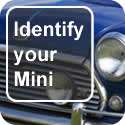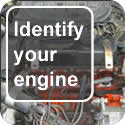NOTE: Please select your car as a Classic Mini to view these articles and guides correctly: Select Your Car
See also our guide: ID your Classic Mini by VIN or Chassis Numbers

- Introduction
- Getting Started
- Why Correct Identification is Necessary
- What to Know to Identify Minis
- Identification by Chassis Number/VIN – Standard Cars
- Identifying Minis by Engine/Power Unit
- Mini Mini History
- Identifying Minis by Mark
- Mk I Austin and Morris: 1959 – 1967
- Mk I Riley Elf and Wolseley Hornet: 1961 – 1962
- Mk II Riley Elf and Wolseley Hornet: 1962 – 1966
- Mk III Riley Elf and Wolseley Hornet: 1966 -- 1969
- Mk II Austin Morris: 1967 – 1969/70
- Mk III: 1969/70 -- 1976
- Clubman: 1969 – 1980/82
- Mk IV: 1976 – 1984
- Mk V: 1984 – 1991/2
- Mk VI: 1991/92 -- 1996
- Mk VII: 1996 – 2000
- Identifying Non-Standard Minis
- Minis Built for Export and Minis Built Outside of the U.K.
|
Use our Visual Interactive Matrix. Select the Mini identification matrix that fits your needs. |
|

Introduction
The following covers the most common Classic Minis; i.e., those built in the United Kingdom. The ones built there for the U.K. market make up about 46% of the 5.3 million Classic Minis built. You can be reasonably safe in extending the information in this article to Minis built in the U.K. for export sale, or those built in the U.K. as "CKD" (Completely Knocked Down kits) that were assembled in other countries. There are exceptions, but they are few enough. This accounts for another 46% of total Minis. So, figure 92% of all the Minis built were done in the U.K.
It is harder to extend the article's discussions to cars built outside of the U.K. -- about 8% of the total. Some exceptions are noted in the article, but exercise caution when dealing with non-U.K.-built cars.
Published information on cars built outside of the U.K. is scarce. For instance, there is one book on Australian cars, which is only marginally helpful ("Mini Minor Down Under", Pedr Davis, ISBN 0-947079-10-6). Nothing major has been published on the South African cars (although the definitive book is in the works), and there is nothing major covering the Italian and Spanish cars, at least in English. There is a short discussion at the end of this article about some of the cars built outside of the U.K. and even some of the differences in U.K.-built cars for export. See "Minis Built for Export and Minis Built Outside of the U.K."
If you are new to Minis, you might want to work your way through the entire article. Follow all the links, or just take a section at a time.
If you are not new to Minis, but haven't been around them too long, you can use the various links to jump to sections that may interest you the most.
And if you have been around Minis for years and see bits missing that you could add to Mini Identification, contact Mini Mania and offer to help fill in the blanks! ([email protected]) If you find errors pass that information on, too.
If your Mini is in standard, factory form (i.e., "stock") then sections like "Identifying Minis by Chassis Number/VIN – Standard Cars," "Identifying Minis by Engine/Power Unit," and the "Mini Mini History" will be helpful. Even if your car has been modified, the same sections should help with identification, depending upon the extent of modifications.
If you go through parts of the identification sections and the history and something doesn't add up, this article may still be helpful. Examples: your car seems to be a cross between a couple of types of Minis, or the Chassis Number/VIN plate is missing, or the engine ID plate is missing. There are a couple of sections that may help. See "Identifying Non Standard Minis," and "Engine ID If the ID Tag Is Missing." Both of these sections will work better if used with the sections on standard Minis and engines.










